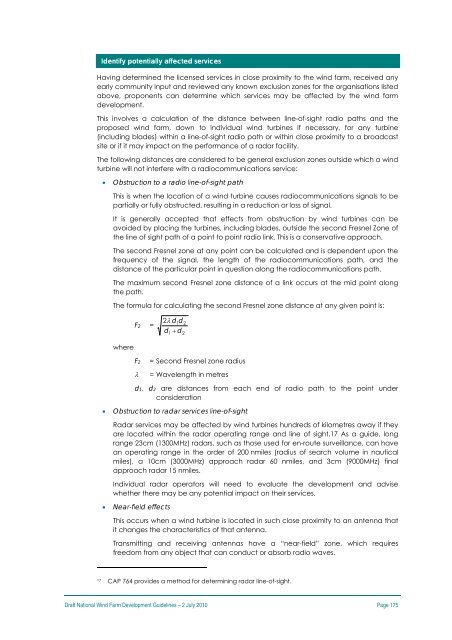Draft National Wind Farm Development Guidelines - July 2010
Draft National Wind Farm Development Guidelines - July 2010
Draft National Wind Farm Development Guidelines - July 2010
You also want an ePaper? Increase the reach of your titles
YUMPU automatically turns print PDFs into web optimized ePapers that Google loves.
Identify potentially affected services<br />
Having determined the licensed services in close proximity to the wind farm, received any<br />
early community input and reviewed any known exclusion zones for the organisations listed<br />
above, proponents can determine which services may be affected by the wind farm<br />
development.<br />
This involves a calculation of the distance between line-of-sight radio paths and the<br />
proposed wind farm, down to individual wind turbines if necessary, for any turbine<br />
(including blades) within a line-of-sight radio path or within close proximity to a broadcast<br />
site or if it may impact on the performance of a radar facility.<br />
The following distances are considered to be general exclusion zones outside which a wind<br />
turbine will not interfere with a radiocommunications service:<br />
• Obstruction to a radio line-of-sight path<br />
This is when the location of a wind turbine causes radiocommunications signals to be<br />
partially or fully obstructed, resulting in a reduction or loss of signal.<br />
It is generally accepted that effects from obstruction by wind turbines can be<br />
avoided by placing the turbines, including blades, outside the second Fresnel Zone of<br />
the line of sight path of a point to point radio link. This is a conservative approach.<br />
The second Fresnel zone at any point can be calculated and is dependent upon the<br />
frequency of the signal, the length of the radiocommunications path, and the<br />
distance of the particular point in question along the radiocommunications path.<br />
The maximum second Fresnel zone distance of a link occurs at the mid point along<br />
the path.<br />
The formula for calculating the second Fresnel zone distance at any given point is:<br />
F2 =<br />
2λ<br />
d d<br />
1<br />
1<br />
2<br />
2<br />
d + d<br />
where<br />
F2<br />
λ<br />
= Second Fresnel zone radius<br />
= Wavelength in metres<br />
d1, d2 are distances from each end of radio path to the point under<br />
consideration<br />
• Obstruction to radar services line-of-sight<br />
Radar services may be affected by wind turbines hundreds of kilometres away if they<br />
are located within the radar operating range and line of sight.17 As a guide, long<br />
range 23cm (1300MHz) radars, such as those used for en-route surveillance, can have<br />
an operating range in the order of 200 nmiles (radius of search volume in nautical<br />
miles), a 10cm (3000MHz) approach radar 60 nmiles, and 3cm (9000MHz) final<br />
approach radar 15 nmiles.<br />
Individual radar operators will need to evaluate the development and advise<br />
whether there may be any potential impact on their services.<br />
• Near-field effects<br />
This occurs when a wind turbine is located in such close proximity to an antenna that<br />
it changes the characteristics of that antenna.<br />
Transmitting and receiving antennas have a “near-field” zone, which requires<br />
freedom from any object that can conduct or absorb radio waves.<br />
17 CAP 764 provides a method for determining radar line-of-sight.<br />
<strong>Draft</strong> <strong>National</strong> <strong>Wind</strong> <strong>Farm</strong> <strong>Development</strong> <strong>Guidelines</strong> – 2 <strong>July</strong> <strong>2010</strong> Page 175
















